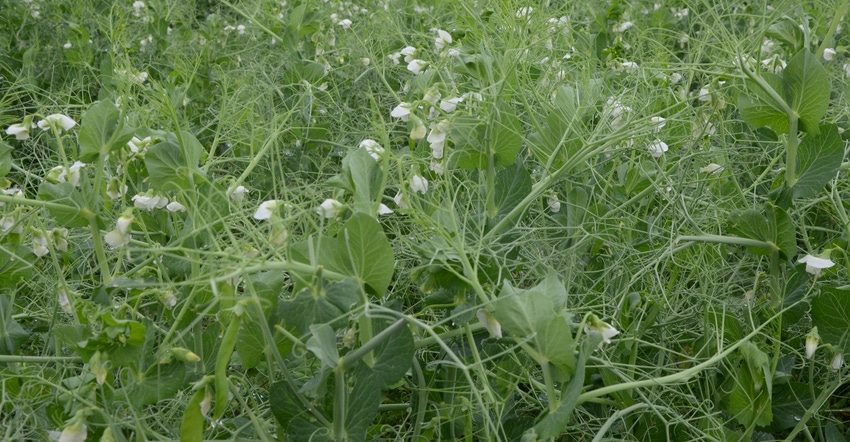
Pulse crop acres in Nebraska have grown significantly in recent years. As of 2017, the combined acreage of yellow field peas, lentils and chickpeas in Nebraska reached an estimated 80,000 acres. The state also has seen a growth in marketing opportunities and processors handling field peas and other pulse crops.
A big part of the appeal of adding pulse crops such as field peas and chickpeas to the rotation is getting more value for the water used to produce a crop compared to fallow.
In 2018, as part of a research project funded by the Nebraska Environmental Trust, the University of Nebraska-Lincoln compared several fallow alternatives, including field peas, chickpeas and soybeans followed by wheat. The research, which took place at the Stumpf Wheat Research Center near Grant, Neb., compared how the different rotations affect the water balance, and how they affected subsequent wheat crop yields.
The study used a neutron soil moisture probe to measure soil moisture down to 5 feet. Below that, the moisture was considered lost to deep percolation.
"Fallow saw the highest subsequent wheat yield — about 83 bushels per acre," says Strahinja Stepanovic, Nebraska Extension educator in Chase County. "Wheat after field peas yielded 6 to 7 bushels less compared to fallow. Chickpeas had a 15- to 20-bushel impact on wheat, and soybeans reduced yields by 40 bushels. Essentially, the closer the time of harvest of your fallow replacement to the time of wheat planting, the bigger impact on next year's wheat yield."
"The water profile behind soybeans and chickpeas was similar, but the yield difference in the subsequent wheat crop was tremendous, which suggests wheat doesn't like to follow dryland soybeans in our area," Stepanovic adds. "The previous soybean yield was about 18 bushels, which is normal here. And chickpeas and field peas made around 30 bushels per acre."
Stepanovic notes 2018 saw a wet spring in Chase County. Early-spring-planted crops such as field peas can take advantage of these earlier rains — and are less likely to lose it to runoff.
"They were better able to use that spring precipitation, and allowed enough time between field pea harvest in July and wheat planting to recover some of that water used, and store some of the rain you might have in July and August," Stepanovic says. "It gives more chance for the wheat to establish itself compared to following chickpeas and soybeans."
Fallow was the only treatment that added water to the soil profile going into wheat — by about 2 inches. There's typically a 5- to 6-bushel penalty for every inch less of water at planting.
However, Stepanovic notes fallow acres lost water to evaporation and deep percolation during the 2018 growing season — water that could have been used through transpiration by field peas.
"Fallow was very inefficient — in 2018, it lost 8 inches to evaporation and 11 inches to deep percolation," Stepanovic says. "We had 22 inches of precipitation in 2018. If you did fallow in a year like 2018, you're going to lose a lot of water to deep percolation or to evaporation. Field peas were the most water-efficient crop, and took 11 inches to produce 30 bushels per acre, but you lose those 11 inches to evaporation or deep percolation if you don't plant anything."
In 2019, Stepanovic and other Nebraska researchers evaluated different pulses in irrigated rotations.
"Where you have a water allocation like we do, in the Upper Republican NRD [Natural Resources District] in southwest Nebraska, we can pump too much in the first four years and have only 5 to 7 inches left for the last year of our allocation," Stepanovic says. "Do you still plant corn or soybeans, when you know you typically don't get much rain in August?"
Earlier-harvested field peas or chickpeas may take advantage of early-season precipitation and cut back on irrigation needs. In 2019, under deficit irrigation (1.8 to 2.3 inches applied), field peas saw a 4- to 5-bushel-per-acre yield increase. However, chickpeas actually saw a yield decrease under deficit irrigation (2.2 inches applied) and full irrigation (4.4 inches applied) — yielding 16.5 and 28.5 bushels per acre less than dryland, respectively.
"With field peas, you need a little water to cool the canopy in those hot summer days when peas are flowering and extend the flowering period," Stepanovic says. "You can get a good response to light irrigation amounts. Chickpeas, however, don't like too much water and are susceptible to disease. The more water you pump, you're creating a more favorable environment for Ascochyta blight."
In 2019, researchers also compared biomass produced by double-cropped forage sorghum behind winter wheat and field peas in an irrigated setting — and Stepanovic notes field peas provide an opportunity for early establishment and increased biomass production under irrigation.
"If you plant forage sorghum right behind wheat, you're going to have issues with volunteer wheat," Stepanovic says. "It's going to outcompete forage sorghum, and you won't have as much biomass. You're also going to have to apply at least 40 to 100 pounds of nitrogen.
"Peas are typically harvested five to seven days after wheat. The same day you harvest peas, you can drill forage sorghum and not worry about fertilizer or herbicide. There's plenty of residual nitrogen, and there's no volunteer wheat that's going to compete for water or nutrients. In 2019, we saw twice as much growth in forage sorghum behind peas as forage sorghum behind wheat."
About the Author(s)
You May Also Like






